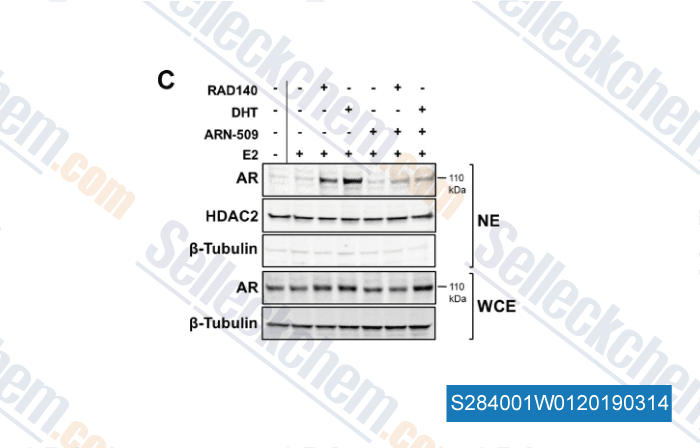|
Toll Free: (877) 796-6397 -- USA and Canada only -- |
Fax: +1-832-582-8590 Orders: +1-832-582-8158 |
Tech Support: +1-832-582-8158 Ext:3 Please provide your Order Number in the email. |
Technical Data
| Formula | C21H15F4N5O2S |
||||||
| Molecular Weight | 477.43 | CAS No. | 956104-40-8 | ||||
| Solubility (25°C)* | In vitro | DMSO | 95 mg/mL (198.98 mM) | ||||
| Ethanol | 28 mg/mL (58.64 mM) | ||||||
| Water | Insoluble | ||||||
| In vivo (Add solvents to the product individually and in order) |
|
||||||
|
* <1 mg/ml means slightly soluble or insoluble. * Please note that Selleck tests the solubility of all compounds in-house, and the actual solubility may differ slightly from published values. This is normal and is due to slight batch-to-batch variations. * Room temperature shipping (Stability testing shows this product can be shipped without any cooling measures.) |
|||||||
Preparing Stock Solutions
Biological Activity
| Description | Apalutamide (ARN-509) is a selective and competitive androgen receptor inhibitor with IC50 of 16 nM in a cell-free assay, useful for prostate cancer treatment. Phase 3. | ||
|---|---|---|---|
| Targets |
|
||
| In vitro | ARN-509 (< 10 μM) inhibits androgen-mediated induction or repression of mRNA expression levels for 13 endogenous genes including PSA and TMPRSS2 in the LNCaP/AR prostate cancer cell line. ARN-509 (< 10 μM) inhibits the proliferative effect of R1881 (30 pM) in the LNCaP/AR prostate cancer cell line. ARN-509 (10 μM) impairs AR nuclear localization and thus reduces the concentration of AR available to bind androgen response elements (ARE) in LNCaP cells expressing AR-EYFP. ARN-509 (10 μM) is able to effectively compete with R1881 (1 nM) and prevent AR from binding to promoter regions. ARN-509 inhibits R1881-induced VP16-AR–mediated transcription with IC50 of 0.2 μM in Hep-G2 cells expressing a VP16-AR fusion protein and an ARE-driven luciferase reporter. [1] |
||
| In vivo | ARN-509 (10 mg/kg/d, oral) inhibits tumor growth with decreased proliferative index and increased apoptotic rate in castrate male immunodeficient mice harboring LNCaP/AR-luc xenograft tumors. ARN-509 dose dependently inhibits tumor growth with highest efficacy at dose of 30 mg/kg/day in castrate male immunodeficient mice harboring LNCaP/AR-luc xenograft tumors. ARN-509 dosed at 10 mg/kg/d for 28 days results in a 3-fold reduction in prostates weight associated with lacking glandular secretory activity and 1.7-fold reduction in epididymis weight in adult male dogs. ARN-509 (10 mg/kg/d, oral) inhibits cell proliferation of prostate tissues in adult male dogs. [1] ARN-509 is safe and well tolerated in 24 patients with metastatic CRPC who has progressed on prior treatments and peak plasma concentrations occurred 2 to 3 hours after administration. ARN-509 results in durable PSA declines at doses ranging from 30 to 300 mg in patients with metastatic CRPC. [2] ARN-509 shows powerful anti-cancer activity and induces durable remissions long after therapy completion in castrate resistant prostate cancer mouse models. [3] |
Protocol (from reference)
| Cell Assay: |
|
|---|---|
| Animal Study: |
|
References
|
Customer Product Validation

-
, , J Cancer, 2014, 5(2):133-42.

-
Data from [Data independently produced by , , Clin Cancer Res, 2017, 23(24):7608-7620]
Selleck's Apalutamide (ARN-509) has been cited by 33 publications
| Macrophage-targeting nano-formulated bicalutamide alleviates colitis by inducing MAP3K1-mediated degradation of NLRP3 [ J Control Release, 2025, 380:417-432] | PubMed: 39892647 |
| Increased translation driven by non-canonical EZH2 creates a synthetic vulnerability in enzalutamide-resistant prostate cancer [ Nat Commun, 2024, 15(1):9755] | PubMed: 39567499 |
| Understanding the function of Pax5 in development of docetaxel-resistant neuroendocrine-like prostate cancers [ Cell Death Dis, 2024, 15(8):617] | PubMed: 39183332 |
| Glucocorticoid treatment influences prostate cancer cell growth and the tumor microenvironment via altered glucocorticoid receptor signaling in prostate fibroblasts [ Oncogene, 2024, 43(4):235-247] | PubMed: 38017134 |
| Acetylated KHSRP impairs DNA-damage-response-related mRNA decay and facilitates prostate cancer tumorigenesis [ Mol Oncol, 2024, 10.1002/1878-0261.13634] | PubMed: 38501452 |
| Acetylated KHSRP impairs DNA-damage-response-related mRNA decay and facilitates prostate cancer tumorigenesis [ Mol Oncol, 2024, 18(9):2314-2330] | PubMed: 38501452 |
| A Genome Wide CRISPR Screen Reveals That HOXA9 Promotes Enzalutamide Resistance in Prostate Cancer [ Mol Cell Biol, 2024, 1-14.] | PubMed: 39300912 |
| Synergistic combination therapy with ONC201 or ONC206, and enzalutamide or darolutamide in preclinical studies of castration-resistant prostate cancer [ Am J Cancer Res, 2024, 14(12):6012-6036] | PubMed: 39803644 |
| Loss of LCMT1 and biased protein phosphatase 2A heterotrimerization drive prostate cancer progression and therapy resistance [ Nat Commun, 2023, 14(1):5253] | PubMed: 37644036 |
| Loss of LCMT1 and biased protein phosphatase 2A heterotrimerization drive prostate cancer progression and therapy resistance [ Nat Commun, 2023, 14(1):5253] | PubMed: 37644036 |
RETURN POLICY
Selleck Chemical’s Unconditional Return Policy ensures a smooth online shopping experience for our customers. If you are in any way unsatisfied with your purchase, you may return any item(s) within 7 days of receiving it. In the event of product quality issues, either protocol related or product related problems, you may return any item(s) within 365 days from the original purchase date. Please follow the instructions below when returning products.
SHIPPING AND STORAGE
Selleck products are transported at room temperature. If you receive the product at room temperature, please rest assured, the Selleck Quality Inspection Department has conducted experiments to verify that the normal temperature placement of one month will not affect the biological activity of powder products. After collecting, please store the product according to the requirements described in the datasheet. Most Selleck products are stable under the recommended conditions.
NOT FOR HUMAN, VETERINARY DIAGNOSTIC OR THERAPEUTIC USE.
